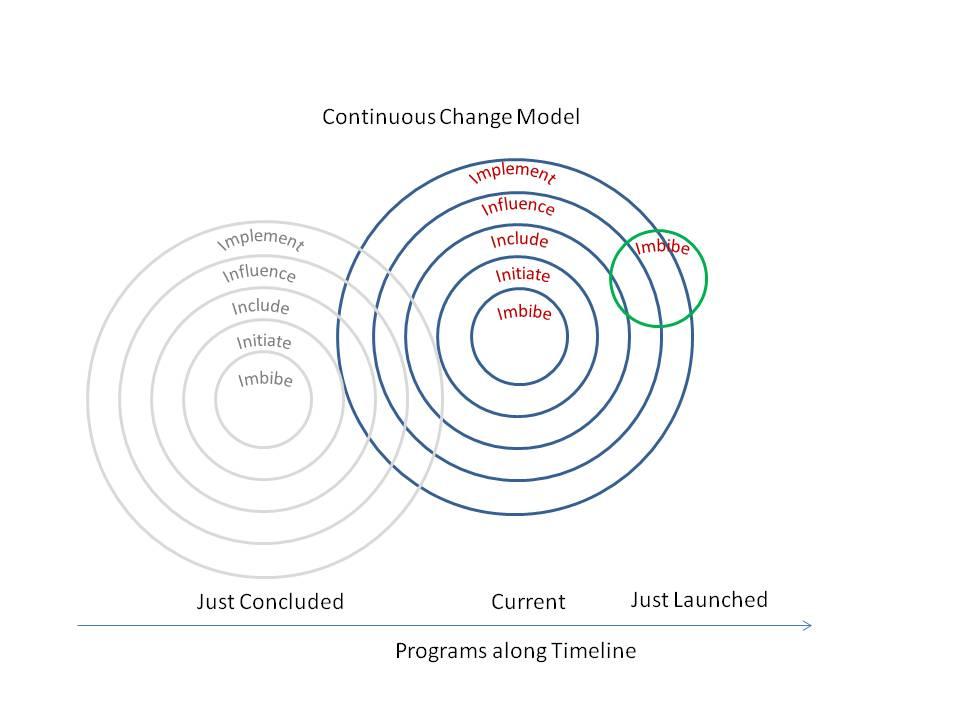
Digital forays have to be constructed on a strong foundation of organization change management that can potentially become challenging and complex due to the very nature of the pursuits. Companies need to shun the traditional sequential and project based approach to change management and practice a continuous change process that is hard-wired into their digital strategy.
Businesses are increasingly seeking to be digital to propel growth and compete successfully in the market place. As they move from taking baby steps to attempting transformational changes, they realize that some significant characteristics define their journey to become truly digital:
- The status quo is often challenged in the attempt to re-define operating models to become more customer centric or introduce innovative products and services or achieve operational excellence.
- The impact is almost always cross-functional as different functions necessarily need to come out of their silos and synchronize their moves.
- Established structures, processes and platforms get re-modeled swiftly and employees shaken out of their routines to achieve the desired makeover.
When companies pick digital momentum, such characteristics compel them to operate in a continuous change mode with intensity levels varying along transactional - transformational -disruptive spectrum. In such a dynamic environment, Change Management (CM) becomes crucial and in fact forms the foundation to rally the organization forward and realize the aspirations. Several questions arise when we look at managing change in the digital era - How should companies strategize and execute CM? Can traditional approach to CM be effective to bring in fast-paced culture? What team structure, methods and tools can help? This article presents a perspective and recommends a different approach to CM to successfully operate as a digital enterprise.
Importance and Challenges of Managing Change
Change Management has always been a complex subject. Businesses have seen more failures in transformation projects primarily due to their casual approach to organization change. Various studies expound the inherent difficulties in effecting change and arriving at factors that can guarantee success. Generally the blame for failures is directed, rather misdirected, at one word ‘resistance’. In fact, research has shown that the actual cause is not the resistance of people but the inability of companies to handhold their employees to navigate the change.
CM can only become more complex and challenging in the digital world due to the very nature of the digital programs. In a radically shifting landscape, traditional methods of CM may not sufficiently address the demands of digital because of some inherent assumptions these were built on. Here are a few pointers:
- Managing change is relatively easy when organizations know where they are headed to. With clarity, they can attempt to sufficiently address the rational, emotional and political factors of those impacted to influence them positively. However, digital initiatives come with uncertainties as companies attempt new business models and unproven solutions with rapid implementations, making it difficult to ascertain outcomes in advance. Such moves may not provide the clarity in scope to plan CM efficiently.
- Traditional methods of CM typically are structured to be carried out as a series of sequential tasks (as in Plan --->Assess ---->Design --->Implement) in a project mode. This is possibly because they were designed to align with enterprise projects such as ERP implementations that are carried out in a sequential mode over long duration typically bringing substantial changes. In the digital era, we find businesses increasingly moving away from such big-bang implementations to adopting a more modular approach and combining them over a period of time to effect larger transformation. Following a sequential process to CM will be detrimental to such a strategy as companies have to shift gears quickly and cannot afford to be in a ‘catching up’ state of organization changes.
- Further, traditional methods recommend a top-down approach to change that is normally carried out by a few executives (or consultants) who would be expected to know the degree of impact and come up with appropriate interventions for the entire organization. Employee involvement happens too late in the change cycle. Successful digital companies have realized that the changes will be effective if they are not seen as a push from the top but designed by the employees themselves working in a collaborative mode. This ensures the crucial aspect of buy-in from those impacted much earlier while they understand the business shifts and prepare themselves to cope with the change.
- ·Companies cannot follow a fixed template for change, another classic legacy approach - every initiative requires different treatment – the impact level may depend on the scope of the digital programs.
A Different Approach to Change Management
Organizations should move away from a sequential and project approach to CM and practice a continuous process that will not only keep pace with the intended business changes but also minimize the side-effects of disturbances to the day-to-day operations and employee involvement.
To start with companies need to establish a dedicated CM team that will form an integral part of the digital strategy team and jointly govern a Digital Program Office. It will be cross-functional with members hand-picked from key departments consisting of unit managers, influential executives and where required representatives of business partners to act as change agents. They of course, need to believe in organization’s vision, assess the impact of the change and more importantly be willing to change themselves first.
The CM team has to follow a more fitting change approach and here is a suggested methodology that involves 5 stages carried out on a continuous basis:
- Imbibe - The CM team should understand and absorb the intent of the digital programs, contribute to strategy, assess the possible impact and align the change plan to the business context. Further, matured digital enterprises may pursue multiple programs in quick succession addressing different business demands. The CM team not only need to multi-task but also assess the possible cross-impacts of such multiple programs.
- Initiate – Initiate involves preparing a CM plan covering communications and implementation aspects of the change programs. As a pre-requisite, the team needs to conduct an impact study that assesses the changes to organization across structure, roles, and processes and also examine possible hurdles that can derail the initiatives. It can tap into organization history or responses to past programs and ensure they are prepared with adequate measures to counter the hurdles.
- Include - Employees and business partners should be encouraged to contribute to effecting the change by sharing ideas on the process and implementation. Towards this, the CM team should bring in the stakeholders on to a common platform where such exchanges can be facilitated. In fact, such an exchange need not be pegged to a project but can be a continuous process. Thus, the ideas and suggestions need not necessarily be restricted to problem on hand but can be more wide-spread and possibly can be used for future programs. The CM team should distill the ideas and suggestions and consider them for bringing the required changes. The company can introduce appropriate reward and recognition schemes to encourage wider participation by the employees.
- Influence - The stage is the classic process of influencing and convincing the employees to align with the new operating models and handholding them to navigate the terrain. CM team can use a mix of traditional and innovative methods including
- communicating through various channels, using platforms such as social media to connect with the employees,
- addressing ‘what-is-in-it-for-me’ concerns and
- conducting one-on-one counseling sessions with employees to address concerns and fears that are deeper in their minds and not normally brought out during regular interactions.
- Implement - Implement stage is without doubt the critical piece of CM. The team needs to work with various functions of the organization for implementation. The changes may cover, depending on the impact, organization structure, roles, appraisal methods and compensation structures.

The 5 stages may overlap across digital programs and the CM team would need to evaluate how best to leverage the efforts of earlier programs and minimize the effort for the current and future programs. The graphic shown here is an early attempt to depict the continuous process of change. The circular representation of the stages is to convey a ripple effect of a proposed change impacting a larger part of the organization. The effort at every stage would involve CM tasks carried out for a specific project as well as leveraging that of earlier and parallel programs (represented as overlaps).
Guiding Principles
Top management commitment, continuous communication, one-on-one interventions at every stage are some basic tenets of managing change. To operate successfully in a digital environment, companies also need to consider the following key principles.
Leading the Charge
As noted earlier, the CM team has to be cross-functional and form an integral part of the digital strategy team. There is an on-going debate on ownership of digital programs whether a company needs the services of a Chief Digital Officer or should do with CMO or CIO. However, not much is said about the responsibility for change. Irrespective of the ownership of the digital programs, the CEO should directly be involved in CM, providing directions and frequently reviewing the progress. He / she may appoint a senior executive to own responsibility for CM and provide on-the-ground support (call it Chief Transformation or Change Officer). The Board has an equally vital role to play and they should be part of the process.
Empowering the CM Team and the Stakeholders
Organizations should promote an open and transparent culture where every employee has equal stake in bringing the new order. The employees and business partners should be seen as the designers of change than just consumers. The CM team itself along with the Program Office should implement a flat structure, encourage open communication and collaboration among the members. The CEO and CXOs should be willing to listen to and act on team members and employee suggestions and consider them on merit even if they are non-traditional.
Demonstrating a Sense of Urgency
Companies have to operate in a fast paced environment of change, taking decisions in real time and implementing swiftly. A sense of urgency should pervade all digital actions and the CM team has a significant role to play in achieving the momentum. It should be comfortable in assimilating data from different sources to study the impact or understand the reactions of the stakeholders. Further, it should continuously explore quick-win opportunities to demonstrate the benefits of change and boost the confidence levels of stakeholders before rolling out in fullness.
Implementing New-Gen Tools to Support CM
Companies should consider deploying platforms that bring the employees together for collaboration and sharing ideas. They should evaluate leveraging social influence and gamification mechanisms to drive change in attitudes and behaviours by integrating such principles into the collaborative platforms.
-------------------------------------------------
In the digital era, organization change cannot be realized by following a piecemeal approach driven by a small group of managers. A continuous change process, a more inclusive and collaborative structure and agile execution are crucial to usher in the new business order that is impactful and employee oriented. CM, thus has to become an organizational capability of companies wanting to move up in the digital ranks.
-----------------------------------------------------
